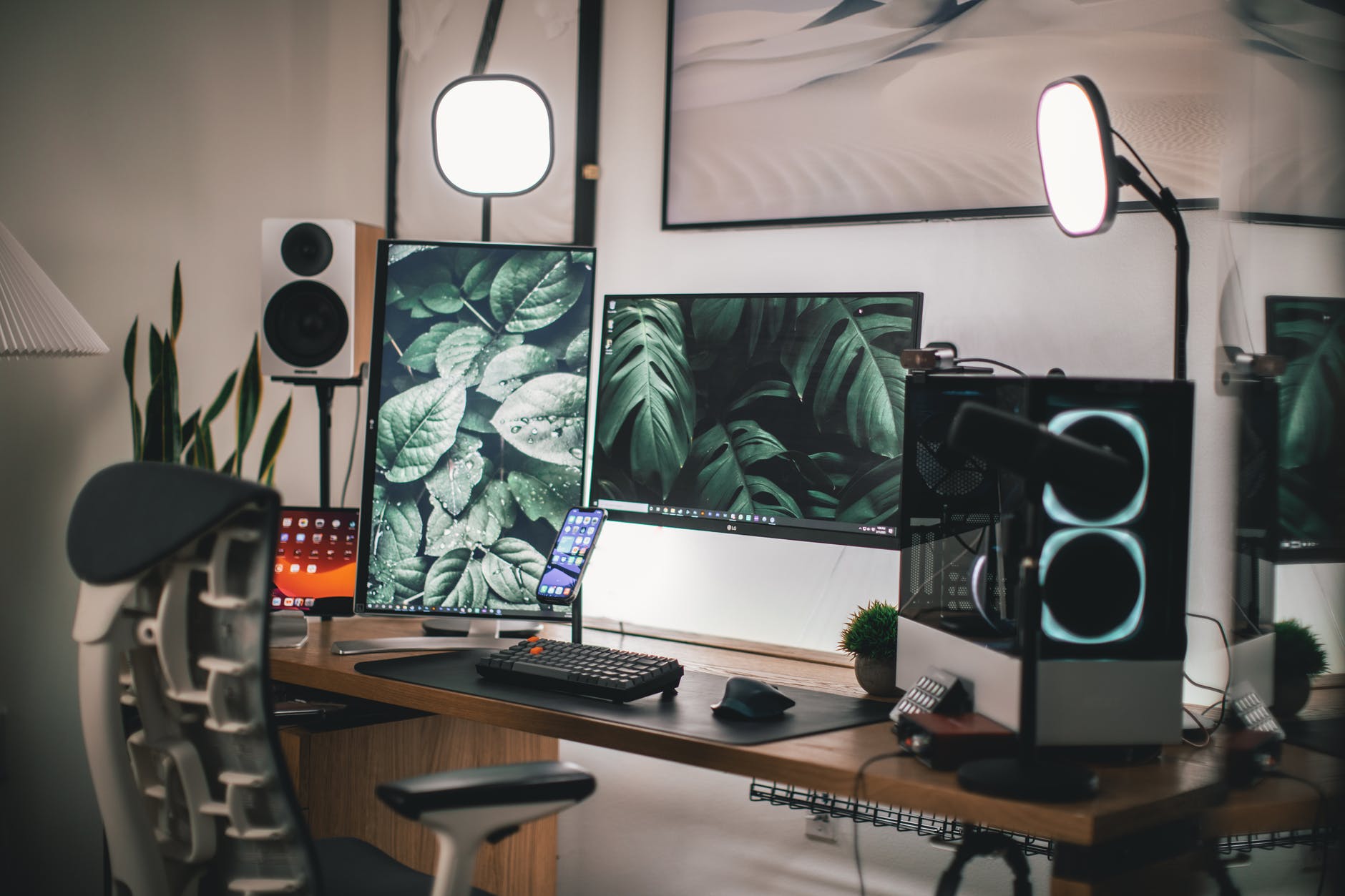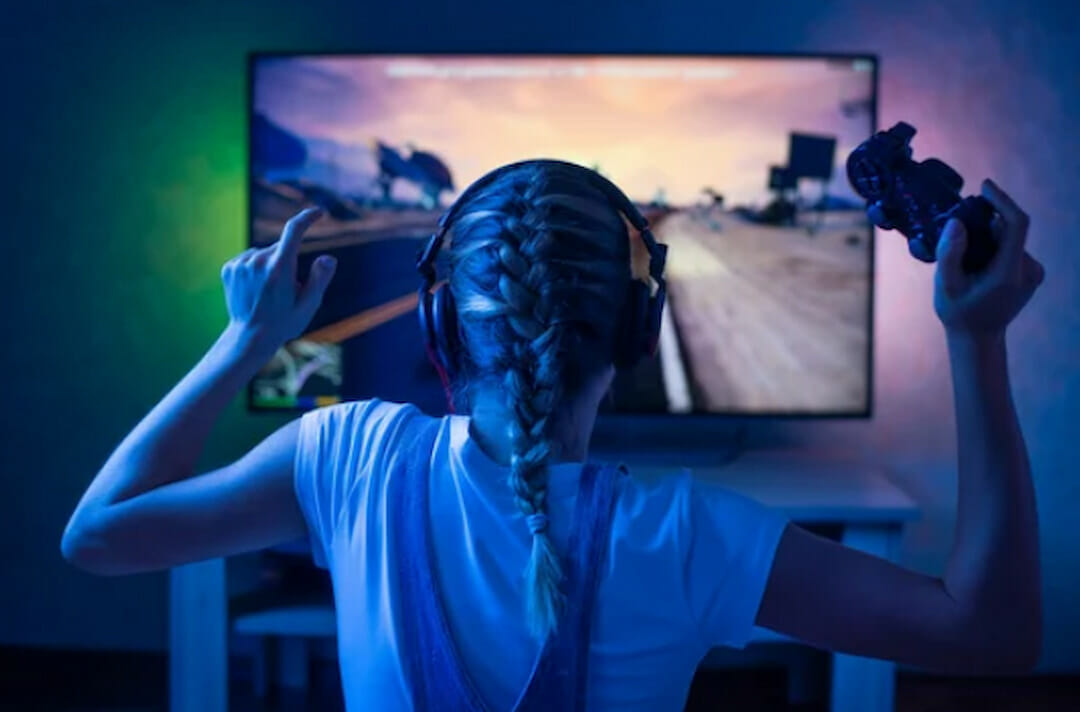Table of Contents
VSync or vertical Sync was the initial syncing technology for GPUs, games, and computer monitors. It synchronizes a game's framerate with that of your monitor. GPU manufacturers established it but later replaced it with more advanced technologies like FreeSync and G-Sync. The function of the VSync is to eliminate screen tearing, an issue that occurs when a display interface displays several frames at a time. It can occur at any time, but it mostly occurs in fast motions, such as when a game is running at high frame rates, exceeding the monitor's ability.
VSync incorporates features designed to eliminate screen tearing in games and monitors. It achieves this by limiting the frame rate of your graphics card and the monitor's refresh rate. Although it works with all kinds of displays, you'll need a graphics card that is compatible with it. Despite VSync being crucial to eliminatine screen tearing, it can significantly reduce your monitor’s performance. Besides, it won't improve the screen's resolutions or color integrity.
What are the Effects of VSync on Graphics?
VSync does not have effects on the graphics quality of a monitor. It is a technology designed to address screen tearing alone and doesn't affect other features of your monitor, like resolution or color integrity. It limits the frame rates to match with the monitor's refresh rate.
VSync only limits your frame rates if it is higher than the refresh rate of your computer monitor. The technology will force mouse lag when the frame rate is higher than the monitor's FPS. This feature can affect your monitor's performance in fast competitive games like Fortnite but eliminates screen tearing.
VSync's effect on FPS is its tendency to limit the FPS. It limits your frame rates to a maximum of 60 if higher than the monitor's refresh rate. This technology would not be necessary if you have an FPS lower than 60.

Should I Have VSync On or Off?
You should have VSync on if your graphics card's frame rates are higher than your monitor's refresh rate. This can be a problem when the monitor fails to display frames. However, it would be unnecessary to have VSync on if your game's frame rate is lower than the refresh rate of your monitor. Therefore, you may turn VSync off.
When to Turn VSync On
The best time to turn VSync on is when you play a game with higher frame rates than your monitor's refresh rate. This allows the frame rate to lower to a limit of 60 fps so that the monitor can display the frames without screen tearing issues.
VSync is compatible with all games. You can access it on your game's graphics settings menu, given a toggle option. VSync Minecraft allows you to lock your graphics card FPS to a fixed amount, such that it can't go past this level when playing games.
Skyrim Special Edition supports uncapped FPs while playing games, although it locks the refresh rate at 60 Hertz. Fallout 4 is also a good alternative to VSync. It locks your graphics card frame rates at 60 Hertz when gaming on the personal computer and 30 fps when playing on a gaming console.
The good thing about Fallout 4 is that you can play a game at frame rates higher than 60, provided you have a powerful rig. VSync is also crucial when playing games like the Apex Legend. Apex Legends VSync needs to be in a dynamic mode if you want the best performance. This feature fully unlocks your graphic card's frame rates.

Which Refresh Rates should you Use VSync for?
You should use VSync on refresh rates of 60 Hertz or lower. Most games have frame rates of up to 60 Hertz with refresh rates higher than 60 Hertz. If your monitor's refresh rate is higher than the graphics card frame rate, it won't be necessary to use VSync.
VSync eliminates screen tearing by limiting the frame rates of your graphics card if it is higher than the maximum monitor refresh rate. Screen tearing is an effect produced on the screen when it attempts to display more than one frame at a time, such that the screen splits into two. It is prevalent in fast-motion games where there are tall vertical objects.
If your frame rate is lower than your monitor's refresh rate, it would be better to leave VSync off. Despite it being a crucial player in screen tearing elimination, it also results in input lag, affecting your gaming performance.
For instance, if your monitor operates at a 100 Hertz refresh rate, yet your GPU has a frame rate of 60, you'll not need to turn VSync on. The graphics card won't maintain the frame rate at 60; it will keep on falling; this value is much lower than the refresh rate, and it won't affect the frames' display on the screen.
To ensure top performance with such a monitor, you shouldn't consider turning VSync on without input lag or judder.

When to Turn VSync Off
Turn VSync off when the graphic's card frame rate is lower than your monitor's refresh rate. If the frame rate is lower than the refresh rate, frames will display without any problems on the screen, and you'll not experience screen tearing.
Also, a graphic's card frame rate can drop while gaming. When this happens, such that the frame rate drops below the monitor's refresh rate, turn VSync off. Leaving it on after the frame rate has decreased beyond the refresh rate will only affect your monitor's performance with input lag and judder.
What are the Benefits of VSync?
The main benefit of VSync is to eliminate screen tearing. It eliminates screen-tearing and promotes smoother, more fluid gameplay. By limiting the graphics card frame rates to match the monitor's refresh rate, it achieves this. A match between the frame and refresh rates results in smooth frame display and image transition for the best gaming experience.
VSync doesn't, however, impact your graphics quality. Resolutions, brightness, and color integrity are not affected by VSync. Neither can it improve these features.
The benefits of VSync are summed up in the list given below.
VSync eliminates screen tearing, resulting in a more focused and better gaming experience.
VSync is compatible with both AMD and NVIDIA graphics cards.
VSync is a graphics card with built-in technology; therefore, you won't incur extra costs.
It decreases strain on your graphics card.
VSync is also friendly to the emulator.
What are the Problems with VSync?
The problem with VSync is that it can significantly affect the performance of your monitor. Limiting the frame rates of your graphics card can lock out some important aspects essential in gaming. VSync also results in input lag and judder. These effects can lower the performance of your monitor in highly competitive matches.
VSync effects on fps include lowering and limiting the frame rates of graphics cards. VSync will lower and lock the fps of your graphics card to a fixed amount if it is higher than the monitor's refresh rate. Locking the frame rate can lock out some important aspects needed in gaming.
VSync problems are listed below.
- VSync increases input lag.
- VSync increases judder.
- It lowers the graphics card frame rate.
- It can also lower the performance of your monitor, providing an awful gaming experience.
How to Turn VSync On
You can turn VSync on by following the set of instructions given below.
- Go to the NVIDIA control panel. You can access the panel from the search bar by inputting the NVIDIA control panel.
- Choose the Manage 3D Settings tab from the options given and click on it.
- Navigate to the Global Setting tab to access a list of features.
- Scroll down a
- The features and click on the Vertical Sync tab.
- Find the dropdown menu on the right of your screen and choose the Force on option.
This set of instructions is the universal procedure for accessing VSync settings. However, the VSync features may differ depending on your graphics card specification. This setup is essential in all games but, remember, you only need to turn on this feature when the frame rate of your graphics card is higher than the refresh rate of your monitor.

How Can You Test VSync?
You can test VSync using the VSync synchronization tester.
Use the set of instructions given below to conduct the test.
- For a new VSync test, you'll see a red 'VSYNC' display indicating one frame. Next to it is the cyan 'VSYNC' display indicating the nest frame. This pattern repeats more and more, with a flickering gray display coming next.
- The V-Sync display should appear as flickering gray if there are no interruptions in the display's alternating frequency. If the display misses even a single frame, the display will appear as a red or cyan "VSYNC" display.
- Suppose the "VSYNC '' display alternates between cyan and red to indicate high-speed images. However, at 60 Hertz refresh rate, you'll see the display as flickering red. But, the gray display stability will depend on your monitor's refresh rate and the viewing angle.
- This VSync technology uses requestAnimationFrame and additive color mixing to test for VSync.
In conclusion, a flickering red display for a 60 fps frame rate means that the rendered frames display and alignment with VSync is proper. Flickering red or cyan means that the frame rate is not properly aligned with VSync.
Another method of testing for VSync is by using vsynctester.com test options.
Follow the guide given below to conduct the test.
- Visit the vsynctester.com web page.
- Press the gear icon on the top right corner of the interface to select a suitable test option.
- A flickering gray "VSYNC" display indicates a properly synchronized VSync. A red or cyan display indicates that VSync is not properly synchronized.
- The RGB customizes the background of the indicator. 0 means black, and 255 shows white.
This VSync indicator automatically switches to several VSync indicators for up to 240 Hertz higher monitor frequencies.
Testing for VSync is important to determine whether your monitor or browser has synchronized properly with the VSync technology. The test is crucial when gaming in competitive and fast games. If VSync is synchronized correctly, the game flow will be smooth, without screen tearing.
What are the VSync Types?
VSync types are listed below.
- Adaptive SYnc
- Enhanced SYnc
- Smooth SYnc
- Fast SYnc
Adaptive Sync
NVIDIA's Adaptive Sync definition is a VSync type that provides for frame rendering using the NVIDIA Control Panel software. To use this VSync type, you need a Graphic card with a GT 600-series NVIDIA graphics card or the latest versions.
Adaptive Sync technology works the same as VSync technology. The difference between them is that Adaptive-Sync limits the frame rates of graphics cards and limits input lag, an initial downside to using VSync. Adaptive Sync dips the refresh to curb input lag, ensuring top performance in gaming monitors.
Unlike the VSync technology that eliminates screen tearing at high frame rates and stuttering at low frame rates, the Adaptive sync technology streamlines the graphics performance of the monitor with the minimum cause of stutter or screen tear.
2. Fast Sync
What is the Fast Sync definition? Fast Sync is a VSync technology alternative designed to eliminate screen tearing, input lag, and latency. It is NVIDIA's newer technology and only works with graphics card specification GTX 900 series, 10-series GPU, or other latest versions. It is a more viable choice for synching technology than VSync as it performs exclusively and consistently in eliminating screen tearing and input lag while keeping input latency at bay.
Unlike VSync technology which can have input latency of up to 100 ms, Fast Sync significantly reduces the input latency to a minimum level, ensuring high performance in gaming monitors.
3. Enhanced Sync
Enhanced Sync definition is a syncing technology developed by AMD. It works as VSync. This sync technology is not a replacement for VSync, but rather a co-technology. They work in unison to eliminate screen stuttering at high frame rates and input lag when the frame rate falls beyond the refresh rate of your monitor. The technology only supports AMD Radeon GPUs.
Enhanced Sync isn't the solution for all problems experienced with VSync. However, it improves the performance and consistency of VSync to achieve a better user experience. Enhanced Sync turns off when the performance of the monitor significantly drops down. This is an effort to prevent the frame rate from dipping further.
4. Smooth VSync
What is Smooth VSync definition? Smooth VSync is a Sync technology developed by NVIDIA. It works by complementing VSync, such that it eliminates screen stuttering when VSync is turned on. It is applied when the Scalable Link Interface is also on. Scalable Link Interface is a graphics card feature for parallel processing algorithms that boost the graphics card processing power. This feature allows you to merge up to four graphics cards to combine processing power for a higher frame rate.
Smooth VSync works a bit differently from VSync technology. It decreases screen stuttering by identifying the most sustainable and stable frame rate and locking it into it. It then increases the game's frame rate if the monitor's response to the performance transition is higher than the monitor's rate. Despite it lowering a game's average frame rate, it improves and smoothens the visual experience of your game, capped with excellent monitor performance.
What are the Alternatives to VSync?
Alternatives to VSync technology are listed below, though you can check out a dedicated post, as well
- AMD FreeSync
- Nvidia G-Sync
1. AMD FreeSync
FreeSync is a sync technology developed by AMD. It allows the graphic card to control a monitor's refresh rate. Monitor refresh rate ranges from 60 Hertz to 240 Hertz. The quality and performance of FreeSync vary depending on the monitor. It is compatible with AMD graphics cards and almost all monitors with no need for the developer's proprietary module. AMD FreeSync works to eliminate screen treating and other gaps left by VSync, such as screen stuttering, input latency, and input lag.
The short side to AMD FreeSync technology is that it has looser standards, which may compromise the consistency of your monitor's performance. Another downside to the FreeSync technology is that every monitor compatible with FreeSync has a standard that varies from each other. Nonetheless, you should still check out if FreeSync is worth it in our detailed guide.
2. Nvidia G-Sync
G-sync is a sync technology developed by NVIDIA. It works to eliminate screen tearing and stuttering. These results are achieved through refresh rate and graphics cards frame rate synchronization. The dynamic synchronization of the two aspects ensures the monitor delivers smooth and excellent game performance.
The downside to NVIDIA G-Sync technology is that it is only compatible with NVIDIA graphics cards. If you have an AMD graphic card, you'll need to replace it with an NVIDIA graphics card. Besides, it is a more expensive option than other sync technologies.
AMD FreeSync and NVIDIA G-Sync are similar in some ways. First, they were both designed to improve the gaps left by VSync technology. Also, they both synchronize the graphics card frame rate with the monitor's refresh rate to achieve better performance. They improve the precision and uniformity of graphics displayed on monitors while gaming.
The difference between AMD FreeSync and NVIDIA G-Sync technologies is that FreeSync is developed by AMD, while NVIDIA develops G-Sync. In addition, FreeSync supports AMD's GPUs, while G-Sync only supports NVIDIA graphics cards.
There are alternatives to VSync technology due to gaps left unaddressed by VSync. Such gaps are input lag, input latency, and screen stuttering. These issues overburden the monitor even after VSync is enabled. Therefore alternative sync technology was necessary to address these issues fully.


